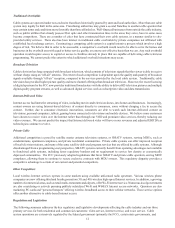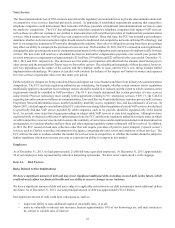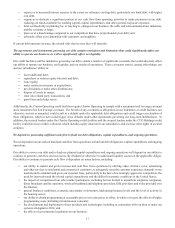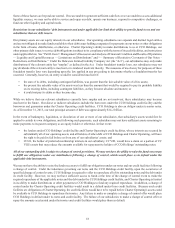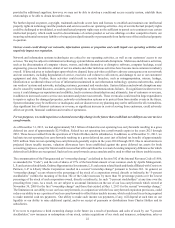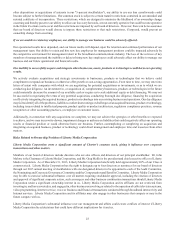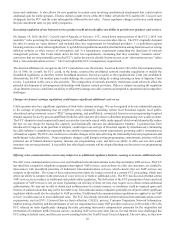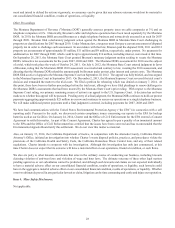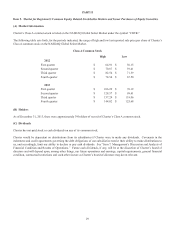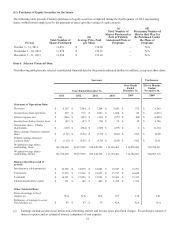Charter 2013 Annual Report Download - page 36
Download and view the complete annual report
Please find page 36 of the 2013 Charter annual report below. You can navigate through the pages in the report by either clicking on the pages listed below, or by using the keyword search tool below to find specific information within the annual report.22
provided by additional suppliers; however, we may not be able to develop a conditional access security system, establish these
relationships or be able to obtain favorable terms.
We further depend on patent, copyright, trademark and trade secret laws and licenses to establish and maintain our intellectual
property rights in technology and the products and services used in our operating activities. Any of our intellectual property rights
could be challenged or invalidated, or such intellectual property rights may not be sufficient to permit us to continue to use certain
intellectual property, which could result in discontinuance of certain product or service offerings or other competitive harm, our
incurring substantial monetary liability or being enjoined preliminarily or permanently from further use of the intellectual property
in question.
Various events could disrupt our networks, information systems or properties and could impair our operating activities and
negatively impact our reputation.
Network and information systems technologies are critical to our operating activities, as well as our customers' access to our
services. We may be subject to information technology system failures and network disruptions. Malicious and abusive activities,
such as the dissemination of computer viruses, worms, and other destructive or disruptive software, computer hackings, social
engineering, process breakdowns, denial of service attacks and other malicious activities have become more common in industry
overall. If directed at us or technologies upon which we depend, these activities could have adverse consequences on our network
and our customers, including degradation of service, excessive call volume to call centers, and damage to our or our customers'
equipment and data. Further, these activities could result in security breaches, such as misappropriation, misuse, leakage,
falsification or accidental release or loss of information maintained in our information technology systems and networks, and in
our vendors’ systems and networks, including customer, personnel and vendor data. System failures and network disruptions may
also be caused by natural disasters, accidents, power disruptions or telecommunications failures. If a significant incident were to
occur, it could damage our reputation and credibility, lead to customer dissatisfaction and, ultimately, loss of customers or revenue,
in addition to increased costs to service our customers and protect our network. These events also could result in large expenditures
to repair or replace the damaged properties, networks or information systems or to protect them from similar events in the future.
System redundancy may be ineffective or inadequate, and our disaster recovery planning may not be sufficient for all eventualities.
Any significant loss of Internet customers or revenue, or significant increase in costs of serving those customers, could adversely
affect our growth, financial condition and results of operations.
For tax purposes, we could experience a deemed ownership change in the future that could limit our ability to use our tax loss
carryforwards.
As of December 31, 2013, we had approximately $8.3 billion of federal tax net operating loss carryforwards resulting in a gross
deferred tax asset of approximately $2.9 billion. Federal tax net operating loss carryforwards expire in the years 2021 through
2033. These losses resulted from the operations of Charter Holdco and its subsidiaries. In addition, as of December 31, 2013, we
had state tax net operating loss carryforwards resulting in a gross deferred tax asset (net of federal tax benefit) of approximately
$276 million. State tax net operating loss carryforwards generally expire in the years 2014 through 2033. Due to uncertainties in
projected future taxable income, valuation allowances have been established against the gross deferred tax assets for book
accounting purposes, except for future taxable income that will result from the reversal of existing temporary differences for which
deferred tax liabilities are recognized. Such tax loss carryforwards can accumulate and be used to offset our future taxable income.
The consummation of the Plan generated an “ownership change” as defined in Section 382 of the Internal Revenue Code of 1986,
as amended (the “Code”), and the sale of shares of 27% of the beneficial amount of our common stock by Apollo Management,
L.P. and certain related funds, Oaktree Opportunities Investments, L.P. and certain related funds and funds affiliated with Crestview
Partners, L.P. to Liberty Media Corporation resulted in a second "ownership change" pursuant to Section 382. In general, an
“ownership change” occurs whenever the percentage of the stock of a corporation owned, directly or indirectly, by “5-percent
stockholders” (within the meaning of Section 382 of the Code) increases by more than 50 percentage points over the lowest
percentage of the stock of such corporation owned, directly or indirectly, by such “5-percent stockholders” at any time over the
preceding three years. As a result, we are subject to an annual limitation on the use of our loss carryforwards which existed at
November 30, 2009 for the first "ownership change" and those that existed at May 1, 2013 for the second "ownership change."
The limitation on our ability to use our loss carryforwards, in conjunction with the loss carryforward expiration provisions, could
reduce our ability to use a portion of our loss carryforwards to offset future taxable income, which could result in us being required
to make material cash tax payments. Our ability to make such income tax payments, if any, will depend at such time on our
liquidity or our ability to raise additional capital, and/or on receipt of payments or distributions from Charter Holdco and its
subsidiaries.
If we were to experience a third ownership change in the future (as a result of purchases and sales of stock by our "5-percent
stockholders," new issuances or redemptions of our stock, certain acquisitions of our stock and issuances, redemptions, sales or


